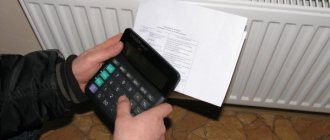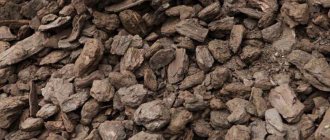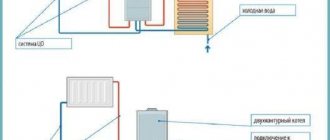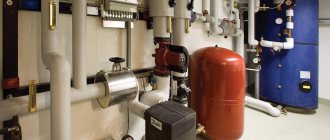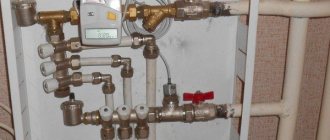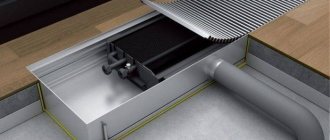In fact, there are no problems associated with what units of measurement to calculate consumed heat, but for the average consumer, not everything is so simple. Difficulties arise only due to the fact that it is necessary to pay for thermal energy consumption in Gcal
, but at the same time, many users have metering devices that produce measurements in
kW
. Accordingly, everything needs to be correctly translated from one unit of measurement to another, that is, in essence, this is a mathematical problem, but many consumers are wondering why such difficulties arise and how to avoid them.
What is Gcal?
We should start with a related definition.
A calorie refers to the specific amount of energy required to heat one gram of water to one degree Celsius (at atmospheric pressure, of course). And due to the fact that from the point of view of heating costs, say, at home, one calorie is a tiny amount, gigacalories (or Gcal for short), corresponding to one billion calories, are used for calculations in most cases. We've decided on this, let's move on. The use of this value is regulated by the relevant document of the Ministry of Fuel and Energy, published back in 1995.
Note! On average, the consumption standard in Russia per square meter is 0.0342 Gcal per month. Of course, this figure may vary for different regions, since everything depends on climatic conditions.
So, what is a gigacalorie if we “transform” it into values that are more familiar to us? See for yourself.
1. One gigacalorie is equal to approximately 1,162.2 kilowatt-hours.
2. One gigacalorie of energy is enough to heat a thousand tons of water to +1°C.
How to calculate the consumed thermal energy?
If for one reason or another there is no heat meter, then to calculate thermal energy you must use the following formula:
Vx(T1-T2)/1000=Q
Let's look at what these symbols mean.
1. V denotes the amount of hot water consumed, which can be calculated either in cubic meters or in tons.
2. T1 is the temperature indicator of the hottest water (traditionally measured in the usual degrees Celsius). In this case, it is preferable to use exactly the temperature that is observed at a certain operating pressure. By the way, the indicator even has a special name - enthalpy. But if the required sensor is missing, then as a basis you can take the temperature regime that is extremely close to this enthalpy. In most cases, the average is approximately 60-65 degrees.
3. T2 in the above formula also denotes the temperature, but of cold water. Due to the fact that it is quite difficult to penetrate the main line with cold water, constant values are used as this value, which can change depending on the climatic conditions outside. So, in winter, when the heating season is in full swing, this figure is 5 degrees, and in the summer, when the heating is turned off, 15 degrees.
4. As for 1000, this is the standard coefficient used in the formula in order to obtain the result in gigacalories. It will be more accurate than if you used calories.
5. Finally, Q is the total amount of thermal energy.
As you can see, there is nothing complicated here, so we move on. If the heating circuit is of a closed type (and this is more convenient from an operational point of view), then the calculations must be made slightly differently. The formula that should be used for a building with a closed heating system should look like this:
((V1x(T1-T)-(V2x(T2-T))=Q
Now, accordingly, to the decoding.
1. V1 indicates the flow rate of the working fluid in the supply pipeline (typically, not only water, but also steam can act as a source of thermal energy).
2. V2 is the flow rate of the working fluid in the return pipeline.
3. T is an indicator of the temperature of a cold liquid.
4. T1 – water temperature in the supply pipeline.
5. T2 – temperature indicator that is observed at the outlet.
6. And finally, Q is the same amount of thermal energy.
It is also worth noting that the calculation of Gcal for heating in this case depends on several notations:
- thermal energy that entered the system (measured in calories);
- temperature indicator during the removal of working fluid through the return pipeline.
What is all this for?
The problem should be considered from two points of view - from the point of view of apartment buildings and private ones. Let's start with the first ones.
Apartment buildings
There is nothing complicated here: gigacalories are used in thermal calculations. And if you know how much thermal energy remains in the house, then you can present the consumer with a specific bill. Let's give a small comparison: if centralized heating operates in the absence of a meter, then you have to pay according to the area of the heated room. If there is a heat meter, this in itself implies a horizontal wiring type (either collector or serial): two risers are brought into the apartment (for “return” and supply), and the intra-apartment system (more precisely, its configuration) is determined by the residents. This kind of scheme is used in new buildings, thanks to which people regulate the consumption of thermal energy, making a choice between savings and comfort.
Let's find out how this adjustment is carried out.
1. Installation of a general thermostat on the return line. In this case, the flow rate of the working fluid is determined by the temperature inside the apartment: if it decreases, the flow rate will accordingly increase, and if it increases, it will decrease.
2. Throttling of heating radiators. Thanks to the throttle, the passage of the heating device is limited, the temperature decreases, and therefore the consumption of thermal energy is reduced.
Private houses
We continue to talk about calculating Gcal for heating. Owners of country houses are interested, first of all, in the cost of a gigacalorie of thermal energy obtained from one or another type of fuel. The table below may help with this.
Table. Comparison of cost of 1 Gcal (including transport costs)
| Name of energy resource | Approximate cost, in rubles* |
| Gas (liquefied) | 520 |
| Gas (natural) | 3 300 |
| Coal | 550 |
| Diesel fuel | 3 270 |
| Pellets | 1 800 |
| Electric Energy | 4 300 |
* - prices are approximate, since tariffs may differ depending on the region, moreover, they are constantly growing.
Subtleties of calculations: high-rise building
Heat is an invisible substance, but despite the fact that it can literally evaporate into the street after being scrapped, there are reliable ways to calculate it. The methods are somewhat different for apartment buildings and private buildings.
In multi-apartment buildings, consumers are billed based on calculations of how much heat remains in the building. At the same time, the question of how heating is measured receives a clear answer: consumption in receipts is indicated in Gcal.
However, central heating in high-rise buildings can function in different ways: without a heat meter or with one, and the meter can be apartment or communal. The simplest calculations will be if there is no meter. When there is no meter, consumption is determined by the area of the apartment, and heating fees are calculated in two ways:
- Payment is made only during the heating season (monthly). It is necessary to multiply three numbers: the area of the apartment, the tariff and the utility consumption standard (per month).
Methods for calculating heating fees Source j.etagi.com
- Payment all year round. The payment amount (the number obtained in the previous paragraph) is multiplied by the number of months of the heating period (for example, 7, from October to April). To find out the monthly fee, divide the resulting number by 12.
With metering devices, adjustment in high-rise buildings is carried out in two ways:
- Household meter. A thermostat is installed on the return branch. Its adjustment determines the heat consumption: with cooling, the consumption increases, with warming it decreases.
- Apartment. Throttling of heating radiators is used. Thermostats are installed on radiators, creating additional resistance in the pressure pipeline. By reducing the passage, the thermostat reduces the temperature, and, consequently, heat consumption.
Heat meters are installed in buildings with horizontal wiring, made in one of two ways: a series or collector system. With a common house meter, heating payments are made on an actual basis, and the total amount of expenses is divided in proportion to the square footage of the apartments. It turns out to be fair: the larger the housing area, the more expensive it turns out.
Heating unit of an apartment building with general metering Source avant18.ru
See also: Catalog of companies that specialize in engineering systems (heating, water supply, sewerage and others) and related work
The calculation is carried out in the following order:
- The area of a particular apartment is divided by the total area of non-residential but heated premises in the building.
- The resulting number is multiplied by the volume of heat spent to heat the building, and then by the current tariff. Initial data is available from the management company (for example, 320 Gcal is required to heat a house).
In new buildings the task is simplified even more. A direct and return pipe is installed in each apartment, which allows you to install heat meters and regulate its consumption at your own request, often balancing between comfort and savings.
Heat meters
Now let’s find out what information is needed in order to calculate the heating. It's easy to guess what this information is.
1. Temperature of the working fluid at the outlet/inlet of a specific section of the pipeline.
2. The flow rate of the working fluid that passes through the heating devices.
Consumption is determined through the use of heat metering devices, that is, meters. These can be of two types, let’s get acquainted with them.
Vane meters
Such devices are intended not only for heating systems, but also for hot water supply. Their only difference from those meters that are used for cold water is the material from which the impeller is made - in this case it is more resistant to elevated temperatures.
As for the mechanism of operation, it is almost the same:
- due to the circulation of the working fluid, the impeller begins to rotate;
- the rotation of the impeller is transmitted to the accounting mechanism;
- transmission is carried out without direct interaction, but with the help of a permanent magnet.
Despite the fact that the design of such meters is extremely simple, their response threshold is quite low, moreover, there is reliable protection against distortion of readings: the slightest attempts to slow down the impeller through an external magnetic field are stopped thanks to an antimagnetic screen.
Devices with a difference recorder
Such devices operate on the basis of Bernoulli's law, which states that the speed of a gas or liquid flow is inversely proportional to its static movement. But how does this hydrodynamic property apply to calculations of working fluid flow? It’s very simple - you just need to block its path with a retaining washer. In this case, the rate of pressure drop on this washer will be inversely proportional to the speed of the moving flow. And if the pressure is recorded by two sensors at once, then the flow can be easily determined, and in real time.
Note! The design of the meter implies the presence of electronics. The vast majority of such modern models provide not only dry information (temperature of the working fluid, its consumption), but also determines the actual use of thermal energy. The control module here is equipped with a port for connecting to a PC and can be configured manually.
Many readers will probably have a logical question: what to do if we are not talking about a closed heating system, but about an open one, in which selection for hot water supply is possible? How to calculate Gcal for heating in this case? The answer is quite obvious: here pressure sensors (as well as retaining washers) are installed simultaneously on both the supply and the “return”. And the difference in the flow rate of the working fluid will indicate the amount of heated water that was used for domestic needs.
We recommend reading: How to insulate a balcony with your own hands: step-by-step instructions for insulating a balcony from the inside
Video description
About the intricacies of calculating heating fees in the following video:
Counter with difference recorder
The operation of the device is based on Bernoulli's law, which relates the speed of fluid flow and its pressure. In the meter, the path of water is blocked by a special retaining washer - a steel disk with a drilled hole of a known diameter.
When the water flow rate changes, the drop on the washer also changes, and the change occurs according to a quadratic law: if the flow rate doubles, then the drop on the washer increases 4 times. If the flow rate, for example, is reduced by 3 times, then the throttled pressure on the washer is reduced by 9 (3²) times.
The registration meter is equipped with an electronic unit that allows you to determine the temperature and flow rate of the coolant, as well as the actual heat consumption. The device can be connected to a computer and configured manually.
Types of electromagnetic heat meters Source energo-climat.com
How are Gcal calculated for hot water and heating?
Heating is calculated using formulas similar to the formulas for finding the value of Gcal/h.
An approximate formula for calculating payment for warm water in residential premises:
P i gv = Vi gv * T x gv + (V v cr * Vi gv / ∑ Vi gv * T v cr)
Values used:
- P i gv – the required value;
- V i gv – volume of hot water consumption for a certain time period;
- T x gw – established tariff fee for hot water supply;
- V v gv – the volume of energy expended by the company that heats it and supplies it to residential/non-residential premises;
- ∑ V i gw – the sum of warm water consumption in all rooms of the house in which the calculation is made;
- T v gv – tariff payment for thermal energy.
This formula does not take into account the atmospheric pressure indicator, since it does not significantly affect the final desired value.
The formula is approximate and is not suitable for independent calculation without prior consultation. Before using it, you need to contact local utility services for clarification and adjustment - perhaps they use other parameters and formulas for calculation.
Calculating the size of the heating fee is very important, since often impressive amounts are not justified
The result of the calculations depends not only on the relative temperature values - it is directly influenced by the tariffs established by the government for the consumption of hot water supply and space heating.
The computational process is greatly simplified if you install a heating meter in an apartment, entrance or residential building.
It is worth considering that even the most accurate meters can allow errors in calculations. It can also be determined by the formula:
E = 100 *((V1 – V2)/(V1 + V2))
The presented formula uses the following indicators:
- E – error;
- V1 – volume of hot water supply consumed upon receipt;
- V2 – consumed hot water at the outlet;
- 100 is an auxiliary coefficient that converts the result into percentages.
In accordance with the requirements, the average error of the calculation device is about 1%, and the maximum permissible is 2%.
Video: example of calculating heating fees
General information about Gcal calculations
To calculate Gcal, it is necessary to make special calculations, the procedure of which is established by special regulations. The calculation is carried out by utility services, which can explain to you the procedure for calculating Gcal, as well as decipher any unclear points.
If you have an individual device installed, you will be able to avoid any problems and overpayments. All you need to do is take the readings from the meter every month and multiply the resulting number by the tariff. The amount received must be paid for the use of heating.
How to convert Gcal to kW/h and Gcal/h to kW
Different metric values are indicated on different devices in the thermal power industry. Thus, kilowatt and kilowatt per hour are often indicated on heating boilers and heaters. Gcal is more often found on counting devices (meters). The difference in values prevents the correct calculation of the desired value using the formula.
To facilitate the calculation process, you need to learn how to convert one value into another and vice versa. Since the quantities have a constant value, this is not difficult - 1 Gcal/h is equal to 1162.7907 kW.
If the value is presented in megawatts, it can be converted back to Gcal/h by multiplying by a constant value of 0.85984.
Below are auxiliary tables that allow you to quickly convert values from one to another:
| Gcal | kW/h |
| 1 | 1163 |
| 2 | 2326 |
| 3 | 3489 |
| 4 | 4652 |
| 5 | 5815 |
| 10 | 11630 |
| 15 | 17445 |
| 20 | 23260 |
Reverse table to the previous one:
| kW | Gcal/h |
| 1 000 | 0,85984 |
| 5 000 | 4,29922 |
| 10 000 | 8,5984 |
| 30 000 | 25,795 |
| 50 000 | 42,992 |
| 100 000 | 85,984 |
| 500 000 | 429,9226 |
| 1 000 000 | 859,8452 |
Using these tables will greatly simplify the process of calculating the cost of thermal energy. In addition, to simplify actions, you can use one of the online converters offered on the Internet that convert physical quantities one into another.
Independent calculation of energy consumption in Gigacalories will allow the owner of residential/non-residential premises to control the cost of utilities, as well as the operation of utilities. By carrying out simple calculations, it becomes possible to compare the results with similar ones in the received payment receipts and contact the relevant authorities in case of a difference in the indicators.
What is a Gigacalorie and how many calories are in it?
The concept of Gigacalories is most often found in documents in the field of thermal power engineering. This value can be found in receipts, notices, payments for heating and hot water.
It means the same thing as a calorie, but in a larger volume, as evidenced by the prefix “Giga”. Gcal determines that the original value has been multiplied by 109. In simple terms: 1 Gigacalorie contains 1 billion calories.
Like the calorie, the Gigacalorie does not belong to the metric system of physical quantities.
The table below shows an example comparison of values:
| Console | Number of calories |
| kcal (kilocalorie) | 1 000 |
| Mcal (megacalorie) | 1 000 000 |
| Gcal (gigacalorie) | 1 000 000 000 |
The need to use Gcal is due to the fact that when heating the volume of water needed for heating and household needs of the population, even 1 residential building releases a colossal amount of energy. Writing numbers denoting it in documents in calorie format is too long and inconvenient.
A value such as a gigacalorie can be found in payment documents for heating
You can imagine how much energy is spent during the heating season on an industrial scale: when heating 1 block, district, city, country.
Gcal and Gcal/h: what is the difference
If it is necessary to calculate the consumer's payment for state heat and power services (house heating, hot water), the value Gcal/h is used. It denotes a reference to time - how many Gigacalories are consumed during heating for a given period of time. Sometimes it is also replaced by Gcal/m3 (how much energy is needed to transfer heat to a cubic meter of water).
The value of Gcal/h can be calculated independently using this formula:
Q=V*(T1 – T2)/1000, where
- Q – amount of thermal energy;
- V – volume of liquid consumption in cubic meters/tons;
- T1 is the temperature of the incoming hot liquid, which is measured in degrees Celsius;
- T2 – temperature of the incoming cold liquid, similar to the previous indicator;
- 1000 is an auxiliary coefficient that simplifies calculations by eliminating numbers in the tenth digit (automatically converts kcal to Gcal).
This formula is often used to construct the operating principle of heat meters in private apartments, houses or enterprises. This measure is necessary when the cost of this utility service sharply increases, especially when calculations are generalized based on the area/volume of the room that is heated.
If a closed type system is installed in the room (hot liquid is poured into it once without additional water), the formula is modified:
We recommend reading: Gas water heater Neva 4511: Technical characteristics and Advantages and disadvantages of the water heater
Q= (( V1* (T1 – T2)) – (V2* (T2 – T)))/ 1000, where
- Q – amount of thermal energy;
- V1 – volume of consumed thermal substance (water/gas) in the pipeline through which it enters the system;
- V2 is the volume of thermal substance in the pipeline through which it returns;
- T1 – temperature in degrees Celsius in the inlet pipeline;
- T2 – temperature in degrees Aim in the outlet pipeline;
- T – cold water temperature;
- 1000 – auxiliary coefficient.
This formula is based on the difference between the inlet and outlet values of the coolant in the room.
Depending on the use of a particular energy source, as well as the type of thermal substance (water, gas), alternative calculation formulas are also used:
- Q= (( V1* (T1 – T2)) + (V1 – V2)*( T2 – T))/1000
- Q= (( V2* (T1 – T2)) + (V1 – V2)*(T1 – T))/1000
In addition, the formula changes if electrical devices are included in the system (for example, heated floors).
Subtleties of calculations: private house
The question of what Gcal is in heating and how it is calculated also arises among owners of private houses. However, heat calculations in the private sector have their own characteristics: owners can influence the price of one gigacalorie by choosing one or another heat source.
Gas boiler in a private house Source tehnoterm.kg
Each location has its own source of heat generation, with optimal prices for connection and operation. Most often, this energy resource is gas, and the coolant in the house is water, but other heat generators (or combinations thereof) are also possible, for example, coal, diesel, firewood or briquettes. Electrical energy is the most expensive resource.
A boiler for a home is purchased taking into account the optimal energy resource and power of the equipment itself. To find out whether the unit is suitable for a given house, calculate the smallest value of its power. To do this, the total area of the house (living and utility rooms) is divided by the specific power of the boiler.
After the boiler has been selected, it is necessary to calculate the heating system, that is, to calculate what parameters the equipment should have, not only the boiler, but also the pump, pipeline, radiators, shut-off and distribution valves. A correctly performed calculation will allow you to obtain a system that provides economical consumption of energy resources and high-quality heating of the house.
Elements of an electric heating circuit Source ytimg.com
There are several methods for calculating indicators. Since operating heating is a rather complex system, they all use corrections, constant values and coefficients in their calculations. It must be remembered that the calculations and selection of system components are influenced by the following loads, which have different origins:
- Permanent. Those that operate year-round. These include hot water supply, and in the northern regions - heating.
- Periodic. The load changes following seasonal changes in air temperature, which are superimposed on daily fluctuations (day and night).
- Convection thermal radiation. Dry heat produced by heating devices is measured with a dry bulb thermometer.
- Taking into account the load from evaporation and condensation. Processes proceed with heat transfer; Latent heat can be determined using a wet bulb thermometer.
General principles of calculations
How thermal energy is calculated is established by PP No. 354. The calculations are carried out by utility companies, but residents themselves are allowed to make them. Heat consumption can be determined after calculating the amount of thermal energy spent on heating per year. This period allows us to obtain an average standard, since costs are lower in summer and more in winter. Payment according to the standard provides for equal costs for the heating period or calendar year.
The calculation scheme depends on several factors:
- equipping the house with a thermal energy meter;
- the ability to account for heating of all rooms using individual devices;
- The calendar time for making payment is winter or all year.
It is more difficult to calculate thermal energy for an apartment building than for a private one. This is due to the presence of common places, residential and non-residential premises, and ownership rights. Taking into account the dependence of heat energy on the dimensions of the room, it is worthwhile to refer to PP No. 354 and PP No. 306. They indicate the distribution of the volume of heat used by the house in proportion to the area of the apartments. The readings of the general meter are divided by the proportion of housing owners.
When is conversion from gigalories to cubic meters necessary?
Resource supply organizations indicate the gigacalories expended in heating bills .
In new buildings, building-wide and apartment-by-apartment metering of heat energy consumption has been introduced.
In older housing stock, installing heat and water supply metering devices is technically complex; in this case, the ability to convert Gcal into 1 m3 of hot water will come in handy.
What is all this for?
The problem should be considered from two points of view - from the point of view of apartment buildings and private ones. Let's start with the first ones.
Apartment buildings
There is nothing complicated here: gigacalories are used in thermal calculations. And if you know how much thermal energy remains in the house, then you can present the consumer with a specific bill. Let's give a small comparison: if centralized heating operates in the absence of a meter, then you have to pay according to the area of the heated room. If there is a heat meter, this in itself implies a horizontal wiring type (either collector or serial): two risers are brought into the apartment (for “return” and supply), and the intra-apartment system (more precisely, its configuration) is determined by the residents. This kind of scheme is used in new buildings, thanks to which people regulate the consumption of thermal energy, making a choice between savings and comfort.
Let's find out how this adjustment is carried out.
1. Installation of a general thermostat on the return line. In this case, the flow rate of the working fluid is determined by the temperature inside the apartment: if it decreases, the flow rate will accordingly increase, and if it increases, it will decrease.
2. Throttling of heating radiators. Thanks to the throttle, the passage of the heating device is limited, the temperature decreases, and therefore the consumption of thermal energy is reduced.
Private houses
We continue to talk about calculating Gcal for heating. Owners of country houses are interested, first of all, in the cost of a gigacalorie of thermal energy obtained from one or another type of fuel. The table below may help with this.
Table. Comparison of cost of 1 Gcal (including transport costs)
* - prices are approximate, since tariffs may differ depending on the region, moreover, they are constantly growing.
Results of calculations of Gcal for heating
If you have correctly calculated the consumption of Gcal of thermal energy, then you do not have to worry about overpayments for utilities. If we use the above formulas, we can conclude that when heating a residential building with an area of up to 200 sq.m. you will need to spend about 3 Gcal in 1 month. If we consider that the heating season in many regions of the country lasts approximately 6 months, then we can calculate the approximate consumption of thermal energy. To do this, multiply 3 Gcal by 6 months and get 18 Gcal.
It is much easier to calculate gigacalorie consumption in a private home, since you can install your own individual device there. In apartment buildings with centralized heating, it will not be possible to get by with a conventional appliance.
Based on the information indicated above, we can conclude that all calculations on the consumption of thermal energy in a particular house can be done independently without the help of special organizations. But it is worth remembering that all data must be calculated accurately using special mathematical formulas. In addition, all procedures must be coordinated with special bodies that control such actions. If you are not sure that you will perform the calculation yourself, then you can use the services of professional specialists who are engaged in such work and have materials available that describe in detail the entire process and photos of heating system samples, as well as their connection diagrams.
Methods for calculating the amount of heat
Formula for calculating gigacalories by room area
You can determine the cost of a gigacalorie of heat depending on the availability of a metering device. Several schemes are used in the Russian Federation.
Payment without meters during the heating season
The calculation is based on the area of the apartment (living rooms + utility rooms) and is made according to the formula:
P=SхNхT, where:
- P – amount to be paid;
- S – size of the area of the apartment or house in m²;
- N – heat expended for heating 1 square in 1 month in Gcal/m²;
- T – tariff cost of 1 Gcal.
Example. The energy provider supplies heat for a one-room apartment of 36 square meters at 1.7 thousand rubles/Gcal. The consumer norm is 0.025 Gcal/m². For 1 month, heating services will be: 36x0.025x1700=1530 rubles.
Payment without meter for the whole year
Without a meter, the calculation formula P=Sx(NxK)xT also changes, where:
- N – rate of thermal energy consumption per 1 m2;
- T – cost of 1 Gcal;
- K – payment frequency coefficient (the number of heating months is divided by the number of calendar months). If the reason for the absence of an accounting device is not documented, K increases by 1.5 times.
Example. A one-room apartment has an area of 36 m2, a tariff of 1,700 rubles per Gcal and a consumer norm of 0.025 Gcal/m2. Initially, you need to calculate the periodicity coefficient for 7 months of heat supply. K=7:12=0.583. Next, the numbers are substituted into the formula 36x(0.025x0.583)x1700=892 rubles.
Cost if there is a common house meter in winter
The cost of a gigacalorie depends on the type of fuel used for a high-rise building.
This method allows you to calculate the price for central heating with a common building meter. Since thermal energy is supplied for the entire building, the calculation is based on area. The formula P=VxS/StotalxT is used, where:
- P – monthly cost of services;
- S – area of a separate living space;
- Stotal – the size of the area of all heated apartments;
- V – general readings of the collective meter for the month;
- T – tariff cost of 1 Gcal.
We recommend reading: Water seal for sewerage - purpose, principle of operation, types and installation instructions with photos and videos
Example. The square footage of the owner’s housing is 36 m2, the entire high-rise building is 5000 m2. Monthly heat consumption is 130 Gcal, the cost of 1 Gcal in the region is 1,700 rubles. Payment for one month is equal to 130 x 36 / 5000 x 1700 = 1591 rubles.
Metering devices are available in all apartments
The cost of heating services using an individual meter is 30% lower.
Depending on the presence of a collective meter at the entrance and a personal appliance in each apartment, there is a change in readings, but this does not apply to tariffs for heating services. Payment is divided between all owners according to area parameters as follows:
- Calculate the difference in heat consumption on the common house and personal meters using the formula Vdiff.=V- ∑Vroom.
- The resulting figure is substituted into the formula P=(Vroom+VрxS/Stotal)xT.
The meanings of the letters are deciphered as follows:
- P – amount to be paid;
- S – indicator of the area of a separate apartment;
- Stotal – the total area of all apartments;
- V – collective heat consumption;
- Vpom – individual heat consumption;
- Vр – difference in readings of individual and household appliances;
- T – tariff cost of 1 Gcal.
Example. In a one-room apartment of 36 m2, an individual meter was installed, which showed 0.6. On the brownie it reads 130, a separate group of devices gave 118. The square footage of a high-rise building is 5000 m2. Monthly heat costs are 130 Gcal, payment for 1 Gcal in the region is 1,700 rubles. First, the difference in readings Vр = 130 - 118 = 12 Gcal is calculated, and then a separate payment P = (0.6 + 12 x 36 / 5000) x 1700 = 1166.88 rubles.
Applying a multiplying factor
Based on PP No. 603, heating fees are charged 1.5 times more if the meter is not repaired within 2 months, or if it is stolen or damaged. An increasing factor is also established if homeowners do not transmit the readings of the device or twice do not allow specialists to check its technical condition. You can independently calculate the increasing coefficient using the formula P=Sx1.5 NxT.
Formula for calculating thermal energy (per 1 square meter)
The exact formula for calculating thermal energy for heating is taken in the ratio of 100 W per 1 square. During the calculations, it takes the form:
Q = (S × 100) × a × b× c × d × e × f × g × h × i × j × k × l × m.
Latin letters indicate correction factors:
- a is the number of walls in the room. For an internal room it is 0.8, for one external structure - 1, for two - 1.2, for three - 1.4.
- b – location of external walls along the cardinal directions. If the room faces north or east - 1.1, south or west - 1.
- c – the ratio of the room to the wind rose. House on the windward side - 1.2, on the leeward side - 1, parallel to the wind - 1.1.
- d – climatic conditions of the region. Indicated in the table.
| Temperature, degrees | Coefficient |
| From -35 | 1,5 |
| -30 to -34 | 1,3 |
| -25 to -29 | 1,2 |
| -20 to -24 | 1,1 |
| -15 to -19 | 1 |
| -10 to -14 | 0,9 |
| To 10 | 0,7 |
- e – insulation of the wall surface. For structures without insulation - 1.27, with two bricks and minimal thermal insulation - 1, good insulation - 0.85.
- f – ceiling height. Indicated in the table.
| Height, m | Coefficient |
| Up to 2.7 | 1 |
| 2,8-3 | 1,05 |
| 3,1-3,5 | 1,1 |
| 3,6-4 | 1,15 |
- g – features of floor thermal insulation. For basements and plinths - 1.4, with insulation on the ground - 1.2, if there is a heated room below - 1.
- h – features of the upper room. If there is a cold hill above - 1, an attic with insulation - 0.9, a heated room - 0.8.
- i – design features of window openings. If there is double glazing - 1.27, single-chamber double-glazed windows - 1, two-chamber or three-chamber glass with argon gas - 0.85.
- j – general parameters of the glazing area. It is calculated by the formula x = ∑Sok / Sp, where ∑Sok is the indicator common to all windows, Sp is the quadrature of the room.
- k – presence and type of entrance opening. A room without a door -1, with one door to the street or loggia - 1.3, with two doors to the street or loggia - 1.7.
- l – battery connection diagram. Listed in the table
| Inset | Peculiarities | Coefficient |
| Diagonal | Supply at the top, return at the bottom | 1 |
| One-sided | Supply at the top, return at the bottom | 1,03 |
| Double sided | Return and supply below | 1,13 |
| Diagonal | Feed below, return above | 1,25 |
| One-sided | Feed below, return above | 1,28 |
| Unilateral | Supply and return below | 1,28 |
- m – specifics of radiator installation. Indicated in the table.
| Connection type | Coefficient |
| Open on the wall | 0,9 |
| On top, hidden by a shelf or window sill | 1 |
| Closed at the top with a niche | 1,07 |
| Covered with a niche/window sill at the top and an overlay at the end | 1,12 |
| With decorative body | 1,2 |
Before using the formula, make a diagram with data for all coefficients.
Metering devices for houses and apartments
A special device allows you to accurately calculate tariffs for water supply, electricity, gas and heat. Users are allowed to install a heat meter to record heat energy consumption. The device measures in Gcal/h, kW/h and kJ/h. Popular today.
Vane meters
The vane meter operates effectively at temperatures below 22 degrees.
The meter has the form of a mechanism with a perpendicular axis of rotation. The model is characterized by low sensitivity, which allows you to accurately measure heat costs. The regulators are suitable for rooms with good thermal insulation and temperatures of +26 degrees. The vane device, when adjusting the temperature up to +22 degrees, counts a minimum of Gcal.
Advantages:
- inexpensive cost;
- power supply from batteries;
- ease of use;
- accuracy of measurements.
Minuses:
- risk of breakdowns due to water hammer;
- rapid wear of the mechanism;
- increased pressure in the system;
- When the impeller jams, the water flow is not allowed to pass through.
Vane-type devices are suitable for taking readings when a small volume of water is used.
Devices with jump recorders
Electronic devices are more expensive, but they count gigacalories more accurately.
The pulse device takes readings remotely from 2-16 channels, so it is suitable for a private or apartment building. Data recording and transmission is carried out on an LCD monitor, via a plug-in interface, to a laptop or computer using a network cable, or via a GSM network.
The scenario for which readings need to be measured is specified by the user. Ultrasonic devices can be connected to the water and gas supply system, are part of the ASKUE system, or can be combined with the “smart home” system.
Advantages:
- many options for public and private measurements;
- possibility of integration into several accounting systems;
- strength due to the absence of moving parts;
- beautiful appearance and compactness;
- protection from dust and moisture – the meter can be placed in the kitchen or outdoors;
- durable body;
- self-diagnosis functions for problems;
- extensive communication;
- execution with or without a removable computing unit;
- the period between inspections is 6 years, between replacements is 10 years.
Minuses:
- high price;
- communication capabilities depend on the specifics of the output;
- costs for the purchase of flow meters, pressure sensors, remote control modules for basic equipment.
For outdoor use, models with difference recorders with a moisture protection level of IP 68 are suitable.
